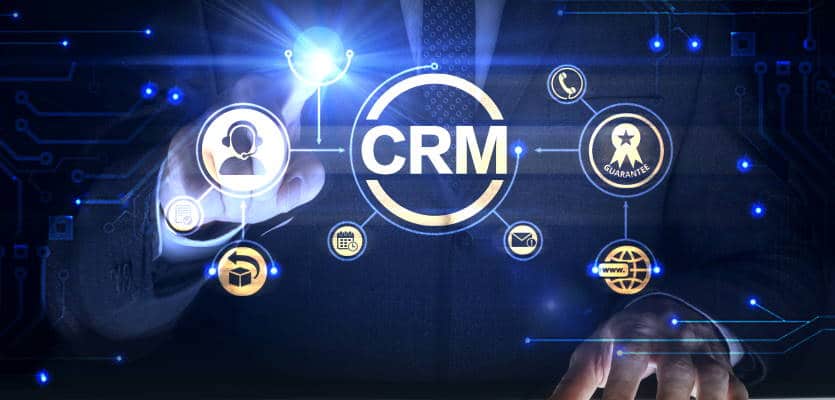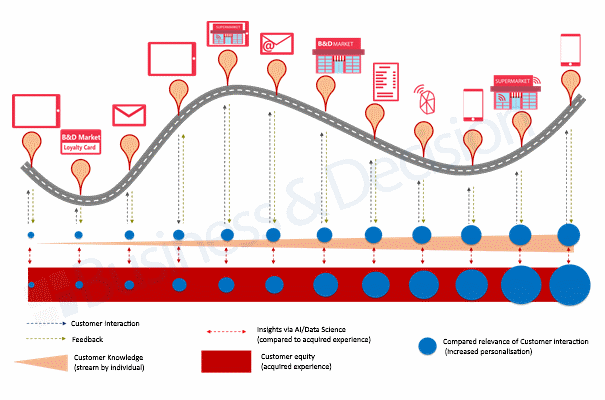For a number of years now, CRM and Marketing subjects have been addressed simultaneously in order to set up a unified platform that could strengthen customer relationship quality regardless of the variety of paths and experiences. As many players are involved, all efforts must first be harmonised and a one and the same customer vision has to be shared: something most organisations have already achieved through different means (training sessions/internal seminars, CRM…).

But today, at a time where the number of communication channels is skyrocketing, the main challenge lies in being able to monitor, understand and enrich customer experience, and in doing so a little more efficiently everyday in order to attract, convince, surprise customers and win their loyalty. Ideally, each interaction should help you get to know them a bit better (whilst complying with the GDPR).
In the diagram below, this is what is referred to as acquired experience, one of the most important resources for any organisation. This is the reason Data Science is increasingly being implemented, namely to accelerate learning, and thus the acquired experience curve which tends to make marketing or CRM actions more relevant, more rapidly.

Successfully creating a seamless, continuous customer experience, in real time
To prepare for the future, the second challenge is moving towards a seamless, continuous customer experience in real time, regardless of the number and variety of contact points in paths. For example, in the cultural sector, if a welcome text message must be sent to a particular visitor who has just used his(her) ticket at the entrance of an exhibition (a patron, a sponsor…), this text must be sent to the visitor mere seconds after his(her) arrival, and this regardless of the number of visitors.
It is therefore necessary that data flows between all customer relationship platform tools be as often as possible moved to real time whilst maintaining the ability to scale up or down dynamically. The same applies for data cross-referencing, analyses and segmentations, even though these are usually asynchronous processes. For example, customer deduplication/merge operations must be performed in real time, regardless of the number of data sources and activity peaks.
Equipping yourself with a cross-functional data platform
More specifically, you usually need to equip yourself with a cross-functional customer data platform. This platform helps you meet the following objectives:
- It groups various facets of Customer knowledge: both raw knowledge and the organisation’s analysis/perception of this knowledge.
- It is a hub: both receiving data from various sources and sending reliable and rich information to consuming applications (several of whom are also data sources). From a technical point of view, the hub also helps reduce dependencies between applications by decreasing the number of interfaces and simplifying the management of interface agreements which always differ from one another and are subject to a variety of constraints: substituting an application for another becomes easier.
- As a hub, it is tasked with validating the quality of received data at input, enriching them and consolidating customers’ paths (deduplication, reconciliation). It can also be enhanced with third-party information, from sources outside of the organisation’s information system (postal addresses, information on tourism websites, weather forecast…).
- It provides a knowledge base that allows the use of Data Science algorithms for deeper analysis/perception.
- It provides an effective response to GDPR by helping to synchronise consents, facilitate anonymisation and the deletion of customer data in all of the information system.
Business & Decision have been Data and Digital experts and already carried out numerous projects and experiments in the field. To date, there exist several solutions that can be used to set up such a platform, bricks’ technical location even varying according to context: in the CRM tool, in the marketing tool, in the Datawarehouse, in a Datalake…
There are several possible paths that can be taken to achieve the final result: starting with a data hub that gradually increases in power, renewing the CRM or Marketing tool, setting up the data quality brick by associating it with the GDPR requirements…
Wish to know more and exchange ideas with our specialists for expert support? Do not hesitate to contact us.
















Your email address is only used by Business & Decision, the controller, to process your request and to send any Business & Decision communication related to your request only. Learn more about managing your data and your rights.